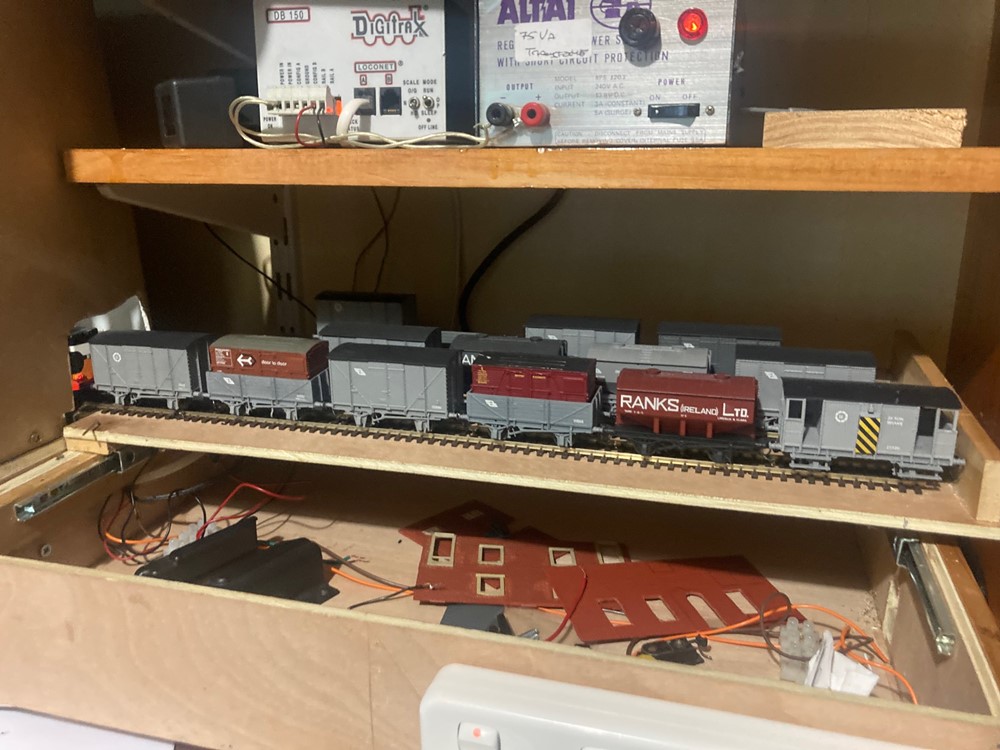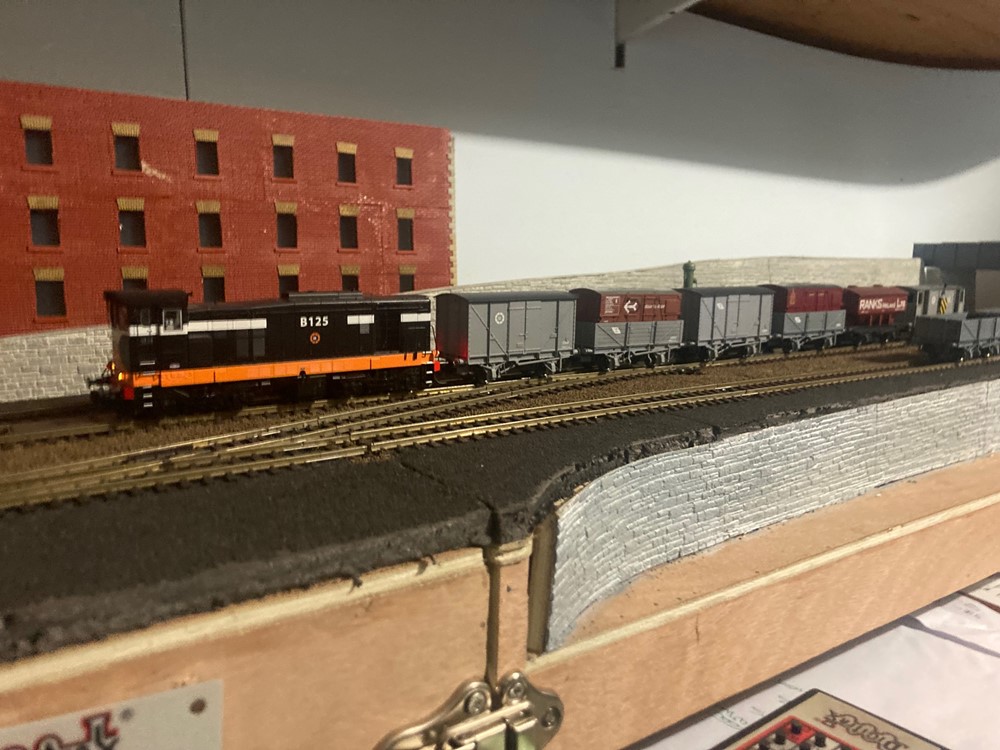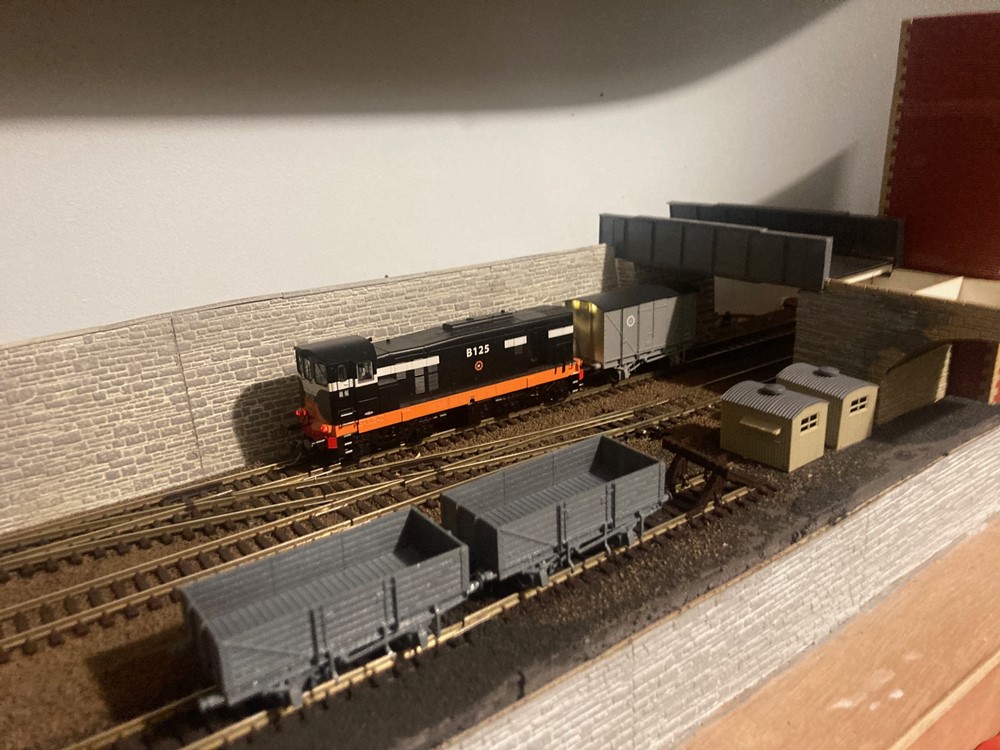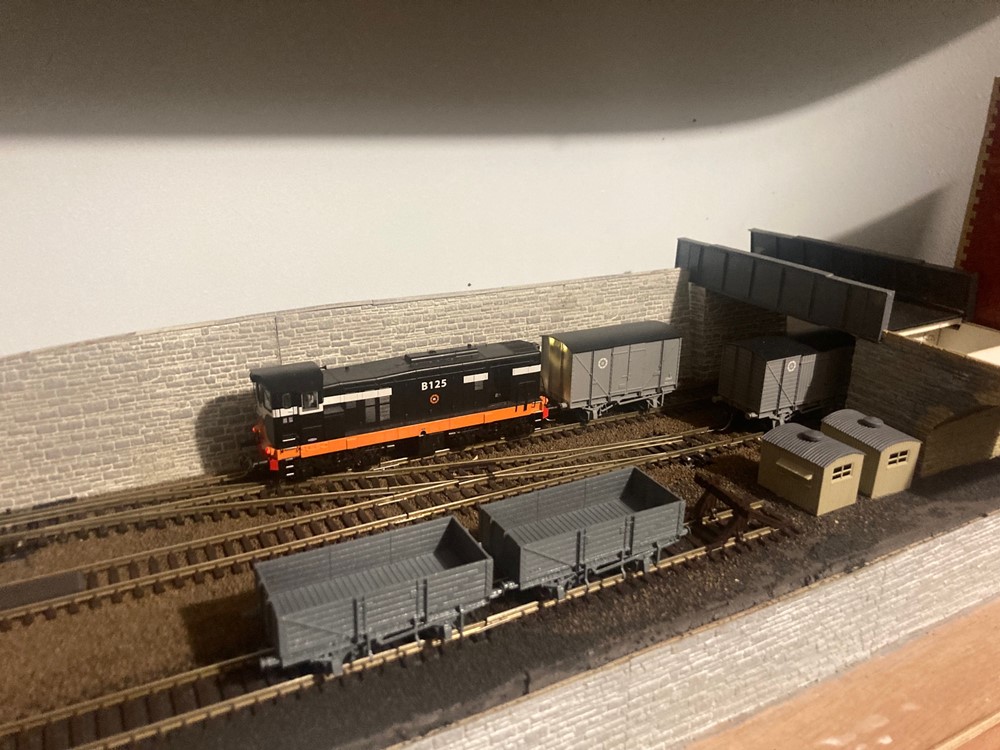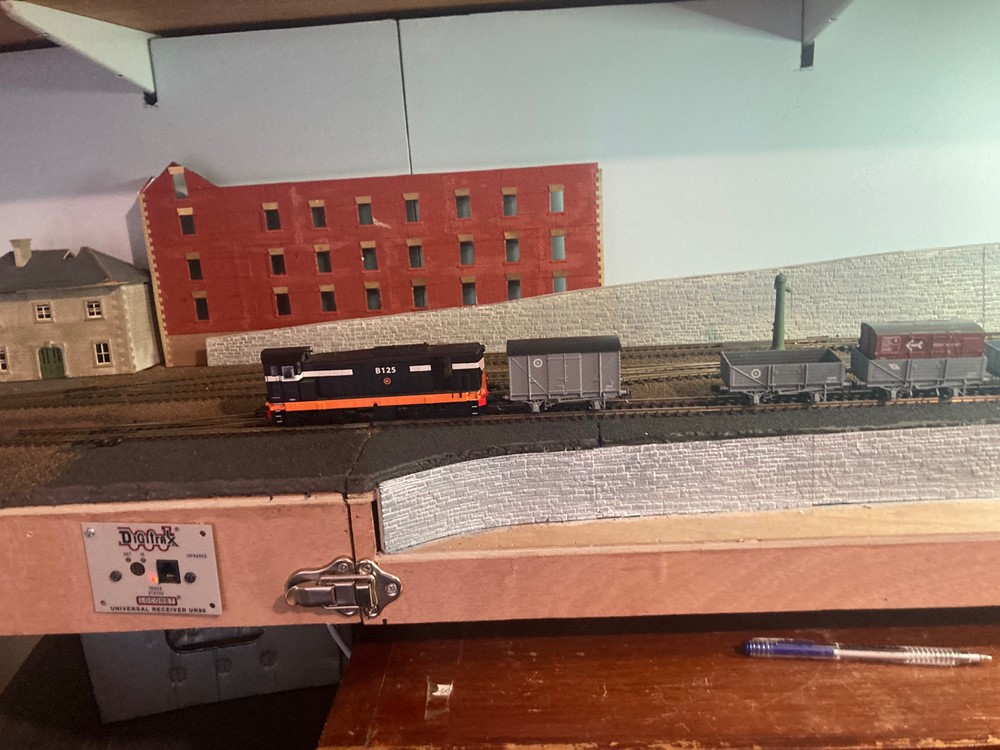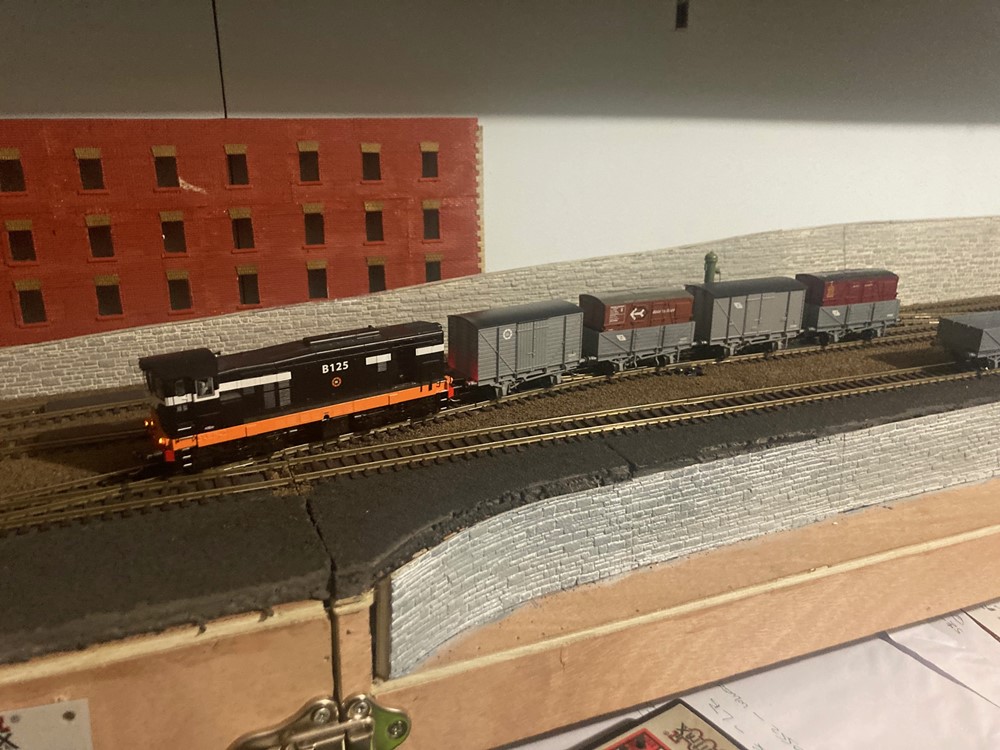-
Posts
4,879 -
Joined
-
Last visited
-
Days Won
119
Content Type
Profiles
Forums
Events
Gallery
Everything posted by Mayner
-
Rocksavage Works was on the West side of the running line 'the siding under a bridge" was used as a loco depot. The Works appears to have been in two parts the 3 road Carriage and Wagons Shops or "old carriage shed" parallel with the running line and the Loco Works at right angles to the carriage shops, reached by a turntable with a separate lead from the Cork City Railway. The Carriage and Wagon Shops/Carriage Shed appears to be reasonably intact into the late 1950s https://www.flickr.com/photos/irishrailwayarchive/52251463031/in/album-72177720300931532/. The Works appears to have been used for carriage and wagon repair up to closure, there is a late 1950s Walther McGrath photo of wagons undergoing running repairs outside the shops while No90 shunts wagons on the main line. Its possible the re-paint took place inside the Carriage Shed or even on one of the several sidings under the Hibernian Road Bridge, the bridge was effectively used as a loco shed after the original running shed was demolished to make way for the Cork City Railway. Rocksavage may have been used for the repaint if works staff were still on the payroll or Glanmire may have been busy with other work. Inchacore had a fairly primitive spray shop until replaced by a modern shop during the 1990s
-
I probably would have gone for a GN V or Vs in sky blue livery with a matching rake of coaches, but I have been planning to build a Cattle Engine for the last 30 odd years. American brass imports seem to have taken off after American servicemen discovered that Japanese and later Korean craftsmen could produce excellent hand crafted models companies such as Precision Scale and Overland Models , there is also a considerable market in European brass manufactured by companies like Fulgurex http://www.fulgurex.ch/en/. American brass seems to be brought as much as an investment as to run on a layout. Athearn, Atlas and Walters were the main brands of plastic rtr models with Bachmann and Lifelike in the toy train category until they started lifting their game in the 1990s. Apart from one or two 1960s GWR imports Japanese or Korean brass never took off in the UK with "Hornby" dominating the UK market until Bachmann Branchlines arrived during the 1990s. Otherwise excellent Airfix and Mainline locos in the 70s and 80s were let down by poorly manufactured mechanisms. Ironically Mainline's models were manufactured by Bachmann and Airfix (later Hornby) by Sanda Kan that was later gobbled up by Bachmann. Iain Rice blamed the poor quality of British rtr models and kits on modellers expecting high quality models at bargain store prices
-
As seen on TV!!!!!!!!!!! I looked at the option of commissioning a rtr OO gauge Cattle Engine from China, I would have needed to sell 500 batch built Brass locos at £700 each or 3000 plastic injection locos at £180 each to cover my costs and make a small profit. OO Works appears to have established that there is a market for 100 Irish steam outline locos at a £315 point which appears very low for a batch built model assembled in the UK (even at home!) At the time I hadn't £300k lying around to see if I could sell 500 Brass or 3000 Plastic Cattle Engines so took a punt on investing a smaller amount in producing some 3D printed rtr wagons which did not exactly pay off either.
-
Potential demand for 1 per-train items Brake, Luggage Vans, Buffet Cars. IRMs, Accurascale and MM business model is largely based on producing coaches and wagons that customers will by in multiple to make up a complete train such as IRM & Accurascale's focus on 'Block Train Wagons, MM production of the Craven and Supertrain coaches. I think its significant that MM did not produce model of the BR Van or Buffet Car (1953) that were used with Craven coaches. The BR Vans were used with the Cravens from the early 1970s to the mid 2000s, while the 1953 Buffet Car ran with the Cravens from the mid-1960s until replaced by "Craven Buffets" during the late 1980s. While widely used I doubt that the Bulleid Vans even in a multi-pack would sell in sufficient quantities to justify producing a rtr model. The Vans were largely used singly and ran within a very restricted time period 1955-late 70s, the majority of 4w vans were withdrawn during the early 70s, a small number of 4w Heating Vans retained for Dublin Suburban and Branch Line trains. Ironically while CIE ran mail and parcel trains made up largely of 4w Luggage Vans, the Heating and Luggage sold better. Sales wise my Bullied Van kits broke down 40% Heating and Luggage, 30% Luggage Van, 10% Post Office/PW Tool Van over two batches. Kits/batch produced rtr Irish models. With the exception of the Bandon Tank and B101 the majority of the SSM kits were developed during the 1980s and 90s before the business was sold to its current owner. Worsley Works continues to produce scratchbuilder parts for Irish locos and rolling stock mainly GNR, NCC and UTA as Northern Modellers continue their great scratch and kitbashing tradition. Parts for BUT, MED, MPD and 70 Class railcars have been released during the past 10 years, apparently with little demand from "Southern Modellers" with no new GSWR/GS/CIE items released since the early 2000s. I am unlikely to produce further JM Design kits unless I want to design and build a model for my own personal use, the business covers its production, but not its design and prototyping costs. Shipping costs from NZ do not appear to be a significant factor, the business has a small but loyal customer base, moving production to Ireland is unlikely to have a significant effect on the price point as I am working from a lower cost base due to the relatively low value of the NZ $ compared to the € or £, Vats not issue as our prices are 0 rated for vat/gst and claim back the vat/gst if any on my input costs. The fundamental problem is there is in-sufficient demand for kits or batch built models in the current environment to make it worthwhile to produce new models. Disappearing manufacturers. Ian McNally's MIR was probably the first casualty of the introduction of the current generation of rtr models, despite re-tooling the majority of his locomotive and rolling stock kits from whitemetal to resin. Although some of the detail was heavy the kits were reasonably accurate models that captured the look of the prototype and easily convertible to 21mm gauge. Model Irish Scale Rail a promising Edenderry based small batch build manufacturer of rtr CIE wagons faded out in the early 2010s after producing creditable models of the CIE H Van and Ballast/Gyspum wagon. MISR planned an extensive range of high quality highly wagons based on existing rtr chassis which may have been too much for a cottage industry operation. The MISR H Van received a positive review in New Lines during the early 2010s. IFM once produced a large range of Irish rtr coaches and wagons based on rtr chassis and running gear during the 2010s, but its currently unclear whether the business is currently in operation. UK losses. Apart from the loss of Eileen's, Photo Etch Consultants ceased trading in 2022. Photo Etch control the tooling and carry out the etching for a number of UK kit manufacturers. Apart from the problem of retrieving the tooling, the closure of the business is likely to result in significant price increases for some brands of etched kits. Photo Etch prices were significantly lower than other photo engraving companies. The good news for customers is that I did not use Photo Etch. Q Kits Colin: As far as I recall Q Kits produced resin models of CIE A Class, B201, B101, E401 and NIR Hunslet. While rough diamonds the Q kits tended to get the basic shape of the Metrovicks and Hunslet correct and the could be completed as a reasonable model. I had a B101 & a E401, I struggled to complete the B101 mainly because I was unable to correct the serious shrinkage/distortion of the body and cut out the windows neatly, the E401 was a reasonable looking model but was unable to find a suitable donor chassis/motor bogie The Metrovicks and Hunslet were marketed by MIR, though the A Class was later replaced by a whitemetal kit produced by MTK (poor quality body castings that did not fit and Class 47 bogie sideframes totally unsuitable for an A Class. Still it was fun to 'assemble" the A Class on a scratchbuilt chassis with Atheran SD9 trucks (bogies), with central flywheel motor driving both bogies extremely unusual for a model of an Irish or British Rail diesel during the early-mid 1990s.
-
Many older more established modellers had similar concerns about the future of railway modelling when I first started modelling as a teenager about 50 years ago. The majority of the older generation modelled the "Big Four"/BR steam era, Irish railways were basically off the radar apart from a small group of scratchbuilders. At the increasing popularity in modelling Irish railways was largely driven by a small group of modellers in Ireland and the UK who during the 1970s/80s built models of Irish locos and stock and a number layouts that appeared at exhibitions and in magazines. The greater interest in Irish modelling encouraged people like Ian Mc Nally (MIR), Terry Mc Dermott (TMD & SSM Kits) and Mike Cole (Q Kits) to produce models of Irish locos and stock (some high quality, others less so). While RTR manufacturers and commissioners have a proven capability to produce high quality rtr models of locos and stock, the availability of relatively low cost models from China is contributing to un-realistic expectations of what can be produced and more seriously a hollowing out of the hobby with the closure of several specialist UK suppliers and kit manufacturers with a potentially serious impact on people who intend to model Irish railways in the steam or transition era. Its unlikely that it would be financially for IRM or MM to produce a representative selection of locos and stock required to operate a CIE 'transition from steam" era layout set during the 1950s while it may be viable to produce a C Class, AEC Railcar set with 1953 Buffet Car, Open Second, Side Corridor, Brake Second, a Park Royal, Laminate coach (post 1956) (3 different types), its unlikely that it would be economic to produce vehicles ran singly (demand 1-2 per customer?) such as BR BSGVs, Bulleid 4w vans. The Steam era opens up its own unique rabbit hole while wooden bodied GSWR/GSR side corridor coaches and Bredin stock were fairly widespread, ex-CBSCR, DSER and MGWR coaching stock were still in widespread use on their sections into the 1950s, MGWR Post WW1 Corridor coaches (most comfortable 3rd/2nd Class coaches in Ireland) were also used on GSWR mail line and Midland 6w scattered far and wide, but seldom appearing in solid trains of 6w stock. Locos open up a whole can of worms passenger trains were largely hauled by pre-amalgamation 4-4-0s until replaced by diesel railcars or locomotives from the mid to the late 50s. GSWR-5 Classes large 4-4-0, 3 Classes small 4-4-0, MGWR 3 Classes large 4-4-0, 1 Class small 4-4-0, 1 Class 2-4-0. The GSWR, MGWR and DSER each had their own "Standard" (J 15 size) and large Classes of Goods Locomotive. What about Tank locomotives, what about the Great Northern, the NCC, BCDR and dare we say it SLNCR with its unique sense of uniqueness.
-
JMRI Operations Pro is now generating longer trains after after some fine tuning to the Locations menu ( basically you have to add an additional 2' to the length of each wagon when calculating siding capacity). All wagons are individually numbered, so need for individual waybills or car markers used with paper based systems. This afternoons Trip made up ready for departure: 1st Van 17113 destined for Track 4 at the rear of the traverser, 2 Opens with containers 10552 & 10568 for the Quayside siding, 2nd Van 17165 to the Milage road & Ranks 2 for the Grain silo. Train arrives at NorthWharf, 1st task is for the entire train to "set back" into the Fiddle Yard uncouple 17113 from the train before shunting to Track 4. In practice the crew would have parked the rear of the train and Brake Van on the Main Line while the loco shunted the yard. There is a good account of CIE goods and mixed train workings in a J P O'Dea IRRS paper on the final days working of the Farranfore-Valencia Branch, the Brake Van and most of the train was left on the main line while the C Class shunted Killorglin Yard. B125 propels 17113 under the overbridge to collect outgoing GSWR Covered 15253 from Track 4 15253 has been parked on the Main Line while B125 sets back into Track 4 with 17165 Track 4 is basically what American modellers describe as an off-scene industry a destination and source of traffic, possibly a warehouse or Granary or an oil depot if I can get my hands on some decent tank wagons! B124 has picked up the two vans and opens and is now preparing to shunt the Wharf Road while Ranks 2 & the Brake Van continue to wait on the main line. Push & Pull B125 has moved 3 vans that were on the Milage Road/wharf headshunt to the main line in order to position Opens 10552 & 10568 on the Wharf Road The crew are not exactly happy with the extra shunt needed to separate 17165 from 10552 and 10568 to position them on the Wharf Road. 125 has moved wagons with outbound traffic Grain 16404, Ranks 2, Vans 17165 & 17121 to the Loading Bank road to clear the main line and loop for the run round move and draw the remainder of the train into the yard. B125 has uncoupled from the train and is preparing to run round. As a timesaving move B125 coupled to Ranks 2 & the Brake Van running round by the loop positioned Ranks 2 at the Silo and the Brake on the Main Line clear of the loop turnout. B125 has shunted the outgoing wagons onto the van including 15253 and is preparing to set back with 17165 to the Loading Bank Road 17165 positioned for loading/unloading with 17012 placed earlier in the week I am planning a loading bank in this area with a canopy for loading bagged mill products. Complete train made up and ready to depart. Hopefully I will make some progress in completing the distillery buildings, retaining walls and over bridge during the holidays, they have been in a hiatus for the best part of 10 years.
- 56 replies
-
- 13
-

-
Personally I like RM Web for the modelling and technical content, kit and scratchbuilding, p.w., signalling, modellers musings due to the greater and wider knowledge base than IRM. The pop-ups are not a problem on my laptop, though both RM Web and IRM are a pain to access on the iPhone.
-
Noel do you view RM Web on a Phone or computer? No problem viewing RM Web (free) or news media on a Laptop, but phone infested with popups trying to sell me things I don't want tailored to my age demographics and personal search pattern.
-
De Selby (Alan) is an accomplished builder of steam locos to S4 standards mainly GN & NCC who occasionally publishes his work on RM Web. Locos include NCC Mogul, Whippet 4-4-0 (scratch) both lined Crimson Lake) GNR Vs, S and U. 650 is de Selbys first "Southern" loco.
-
Best avoid taking a file to the worm. Wear/damage to the worm wheel/pinion usually occurs when the mesh between the worm and worm wheel is too shallow, motor overheats/burns out when its too tight. Best option would be to contact OO Works (return for repair or replace worm and worm gear) as the "Minister" and "Westcorkrailways" experienced similar problems with their Beattie/West Cork 0-6-0STs.
-
A paper on the Meath Line was published in an IRRS Journal during the early 1950s possibly by J O'Meara, the Journal and Meath Road paper may be accessible in the IRRS Library at Heuston. The paper was fairly comprehensive detailing the lines history, description of the stations and traffic handled (early 1950!). There is a good selection of Meath Line stations on the IRRS Flickr site well worth the annual subscription.
-
Link to 'de Selby' 21mm gauge S4 model of 650 complete with working inside valve gear. https://www.rmweb.co.uk/topic/175977-jm-design-650-class/
-
The small scale chassis technology particularly in terms of the adaptation of high quality motors and gearboxes with two stage gearing has developed considerably since the 50s and 60s. OO Works, or similar kit built locos with an all metal chassis gearing and high quality can motors are likely to be more durable in the long term than many mass produced steam out line locos, the downside is the chassis may take longer to run-in because there is likely to be less slop (built in wear) in the running gear, the plus side is the chassis may not wear out as quickly as a loco with a lot of inbuilt slop The combination of a brass or nickel chassis with Markits metal centered wheels running in brass bearings with an all metal or nylon gear train driven by a coreless or high quality can motor, with all metal motion and valve gear (properly assembled) should be virtually bomb proof one run in. Ironically for a long time kit built chassis were considered more reliable and durable than rtr and kit built steam outline locos often used on large UK exhibition layouts such as High Dyke or Stoke Summit because of more reliable running and superior pulling power of a loco with a whitemetal body to haul a long passenger or freight train. Comet ran a very successful business for many years suppling replacement chassis for Airfix, Hornby and Mainline steam outline locos manufactured during the 7os and 80s. Their exhibition display featured a large number of steam outline locos running continuously on Comet chassis (usually with outside valve gear) from exhibition opening time to closing There are well documented problems with zinc rot with Hornby and Heljan chassis, gear splitting and failure with Hornby and Bachmann locos, there were problems with the Bachmann A1 4-6-2 I had to replace the gearbox, leading truck and carry out major chassis repairs on a 10 year old Bachmann Large Scale (1:20.3) 2-8-2.
-
I am planning to re-release undecorated models of all the existing wagons plus additional versions of the Brake Van and GSR Van during the 1st quarter of 2023. I expect to have sample prints of the revised versions of the Brake and GSR Van by late Dec/early Jan.
-
To quote Patrick sssssseriously impressive!!!!!! and an excellent of what can be achieved using traditional scratchbuilding techniques. Very tempted to build a 'steam outline" H&W diesel
-
Hornby (original company) business model was based on selling an Express passenger locomotive from each of the Big Four and a small entry level locomotive for those that could not afford a pacific or a 4-6-0. LMS/LMR----Duchess, LNER/ER Streak (A4), SR/SR West Country and GW/WR Castle. Irish list GSR/CIE 800 Class GNR/CIE/UTA V/Vs Class NCC/UTA Mogul BCDR/UTA---Baltic Tank SLNCR/UTA--Lough Can't see myself buying any of these though I would probably be tempted by a Lough for use on my OO gauge shunting layout or a possible 21mm gauge conversion.
-
Personally I have giving up on converting small kit or batch built locos with high quality motors (Mashima or Coreless) and reduction gearing to DCC and intend to continue running my steam outline locos on straight DC. Apart of the physical challenges of wiring a small loco 2-4-0, 4-4-0 or 0-6-0 for DCC and finding a space for a decoder, finding a decoder suitable for the motors and drive systems used in these locos can be challenging. I converted a pair of OOn3 Tralee & Dingle 2-6-0T to DCC using Digitrax decoders several years ago, but had to re-convert the locos to DC because the decoders had insufficient capatiance to operate reliably at slow speed and there was no space to fit a 'stay alive" capacitor in the loco, more recently I have had problems with "plug & play" decoders blowing up while in programming mode with these types of motor although the motors were well within the decoders current ratings. I am happy enough to continue with DC my kit built locos with Mashima can motors and metal gears some assembled over 20 years ago start and run reliably while some of my DCC fitted rtr diesels are non-runners as a result of component failure. Like many electronic components decoders and circuit boards have a finite life, during the 2000s it was estimated that a high proportion of decoders would fail within 10 years. A high value low volume manufacturer such as OO works is unlikely to have the capability and resources to produce locos in DCC ready or fitted format compared to a high volume rtr manufacturer ----------OO Works---sal3es approx: 100 of type of Irish loco produced Vs ------------2500-10,000---------Chinese mass produced loco
-

Questions on using Electrofrog points on DC layout.
Mayner replied to raymurph's question in Questions & Answers
1. The Seep point motor built in switches are not 100% reliable, I use microswitches to change frog polarity for many years b 2. I haven't had any problems with wheels shorting between a stock rail and an open switch -
I would be seriously tempted by Vs with an Enterprise set as I have convinced myself that I saw a big blue steam engine with smoke deflectors possibly 207 Boyne crossing Gormanstown Viaduct as a child. A Compound and a matching rake of coaches especially in GNR colours would certainly have the wow. factor in terms of a large express passenger steam loco and probably sell well considering the popularity of the GNR among modellers and enthusiasts in GNR territory and mainland UK. I would probably go for the Gauge 1 live steam version, though would probably have to sell most of my stock of American rtr N and Large scale locos and stock.
-
In a "Decade of Steam" on CIE in the 1950s Drew Donaldson, Jack O'Neill and Bill McDonnell RPSI 1974 the authors wrote about Cork (Shed) painting a number of steam locos during the late 50s/early 60s in Grey with black smokeboxes including a no of J15s and an ex MGWR Standard Goods. I have mislaid the page with the numbers many moons ago. CIE retained steam for seasonal Beet Traffic and for shunting and pilot duties until April 1964. Cork's final allocation included J15 118, J9 251, J4 262, Bandon Tank 463 & MGWR small tank 560. 261 & 262 would have been useful for working Beet Specials from the Youghal Branch to the Mallow factory being larger and more powerful locomotives (approx 20%) than a J15 or a 1948 CIE motive power assessment "I would like to see half of the 101 (J15) Class scrapped and many other stray Goods classes and replaced by this design (257/J4 Class).
-
OO Works comment that in later years most superheated locos ran with large and saturated locos ran with small tenders is not strictly speaking correct. The larger tenders tended to be allocated to bot superheated and saturated locos rostered on long distance work (Shipping Specials and long distance goods trains). The pool of large tenders available to work with J15s was fairly limited mainly from scrapped 4-4-0 Classes, and 4-6-0s. It looks like the OO Works loco is based on 186 which is paired with what appears to be a Type C tender used with the larger 4-4-0, 0-6-0, 2-6-0 and 4-6-0 locos introduced from the early 1900s 124 at Thurles 1964 118 Rosslare Harbour (post 57) 181 Cork 1956 133 Carrigaloe 1955 184 Amiens St 1961 183 Waterford 1955 All going well I hope to complete my 21mm gauge superheated J15 from a modified SSM kit by 2030
- 93 replies
-
- 11
-

-

-
Enjoyed the Welshpool video my favourite Welsh narrow gauge line after the WHR. First visited the line in 1980 tramped nearly 3miles from Welshpool to Sylfyn station and back to catch the train as the line did not reach Raven Square for another year, doubt I would be capable of walking that distance these days. Rode behind Hunslet No 14 , a lot in common with WHR Russell, or a scaled down Dingle loco! Interesting to see an Austrian 0-6-2T at Sylfyn, the Welshpool & Llanfair was built to follow the contours with minimal earthworks and sharp curves similar to another 2'6" gauge line the Mariazellerbahn https://en.wikipedia.org/wiki/Mariazell_Railway. which we discovered in 2003 including an operational Engert 0-8-4T
-
The different approach in taken by the GNR and NCC towards railcar development during the 30s & 40s may be as a result of existing agreements with AEC, Gardiner Engines and Leyland for the supply of engines and transmission parts. The GNR appears to have been an AEC & Gardiner company and the NCC a Leyland company. The NCC would have deeper pockets than the GNR which would have allowed York Road to experiment with railcar design while the GNR used proven technology with Atkinson-Walker and AEC/Park Royal after its experiments with railcars A & B The GNR appear to have been an AEC & Gardiner company in terms of its road fleet, while the GSR and NCC were UTA companies NCC Railcar No 1 the progenitor of the British Rail 1st generation DMU survives in RPSI care at Whitehead https://www.steamtrainsireland.com/rpsi-collection/42/railcar-1, York Road continued to be innovative while using a "make do and mend" approach converting existing coaches into diesel railcars under UTA ownership during the 1950s and 60s. The MEDs basically became the proof of concept for the British Rail 1st generation DMUs the MPDs the prototype for the second generation DMUs including NIRs CAFs and IEs 22000 Intercity railcars. The UTA engineers were limited by the limitations of existing engine and transmission technology and having to kitbash their new trains out of existing 'donor" coaches in a similar manner to Darius and Colm Flanagan converting Airfix, Dapol and GMR coaches to AEC Railcars 5-6, MED and MPD units.
-
Its hard to believe that I started this thread just over four years ago and should keep my occupied until Christmas 2030 (if I am still around and capable) at my present rate of progress having just about completed 1 of the 3 J15s. I had planned to finish several CIE Bulleid 4w Vans before resuming work on the J15s but had to put the vans on the backburner as I appear to have mislaid my stock of van decals. Back to the J15s the "Grey Engine" is still awaiting buffer heads, vac pipes, number plates, coal load and couplers (B&B) 229 and the Z boilered loco spent the last 18 months waiting their turn in the Works. Missing parts including tenders and misc. castings used to complete a pair of 52 Class locomotives, Inchacore was a great advocate of standardisation. I have one 1804 gal. tender kit in stock and will probably build a couple of 2730 gal tenders to run with the (saturated) locos rostered to Limierick-Sligo passenger and goods trains. There is a photo of 229 with a 2730 gal tender of an "Overload Goods" at Ballycar and another saturated J15 with a 2730 gal tender approaching Collonney Junction on a Limerick-Sligo goods (saturated locos consumed more water and coal per mile than an equivalent superheated loco) The first task is to short out a driving wheel on each axle in order to convert the wheel sets to live axle pick-up I used to use soft brass wire but etched some "spider" last year to produce a more user friendly solution I carefully opened up the hole in the boss with a tapered broach to allow a tight sliding fit on the axle. I use a small cross locking clamp from Micro Mark as a clamp and heat sink while soldering the legs of the spider to the wheel rim. I use a 145° solder with a phosphoric acid flux which eliminates the risk of the steel wheel tyre rusting. I ran into a snag with the High Level "Load Haulier+" gearboxes originally supplied to motorise the kits as the gearbox carriage is too wide (even in 21mm gauge) for my preferred option of using hornblock bearings on the driven axle to allow all wheel sets to be dropped out for painting and maintenance. Fortunately I had two "Road Runner+" gearboxes with a 60:1 reduction in stock similar to the gearbox used in the 'grey engine" I ran into trouble soldering some of the detail parts that had become damaged/displaced during the past 18 months as I find it difficult to carry out fine work or hold a soldering iron steady as I get older. I screwed a small piece of stripwood to the assembly block as a temporary support while attempting a repair on the sandbox operating rods. 229 Starting to look like a locomotive . I replaced the sandbox operating rod on this side with one of the original brake pull rods as the sandbox operating rod on this side was quite badly distorted. Next job is to set up the driving wheels and gearboxes for both locos, then review the CAD work for the Z boiler conversion.
-
The bogie fertiliser wagons were originally fitted with steel mesh doors and nicknamed "Long Kesh" wagons after the Long Kesh internment camp (Maze Prison) opened in 1972. Its possible CIE built at least one train of wagons with mesh doors before changing to ply sheeting because the Long Kesh wagon nickname appeared to be common at the time. The change to sheet metal or ply was likely to have been an attempt to reduce the risk of bags bursting and the wagon becoming unstable in the event of the load shifting, a fairly common problem with wagons carrying palletised loads
.png.c363cdf5c3fb7955cd92a55eb6dbbae0.png)



